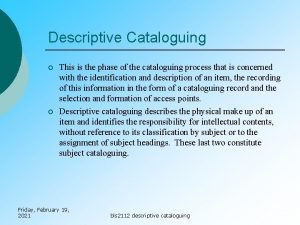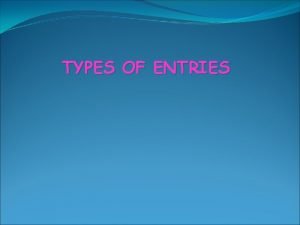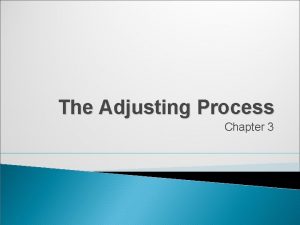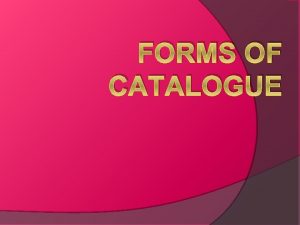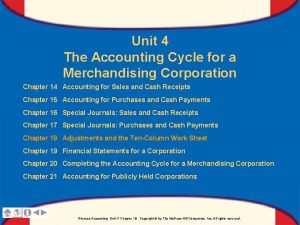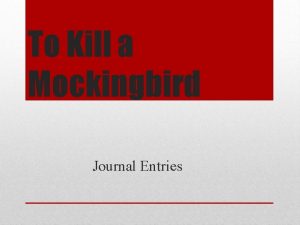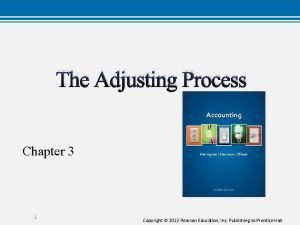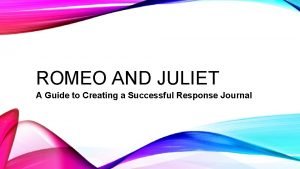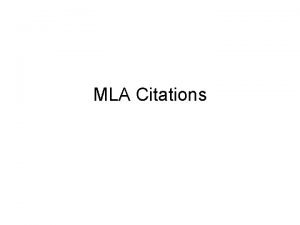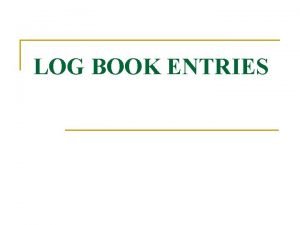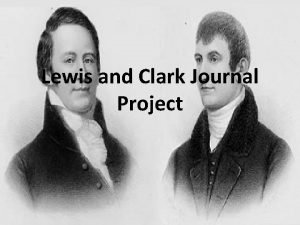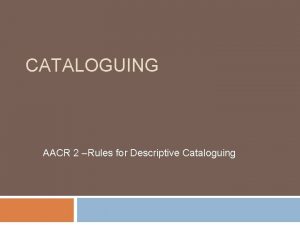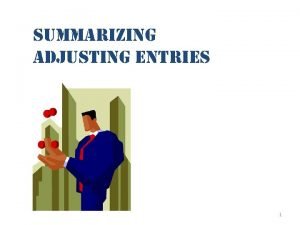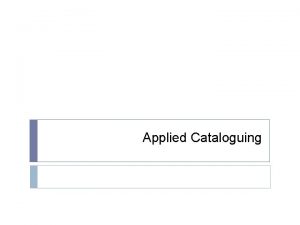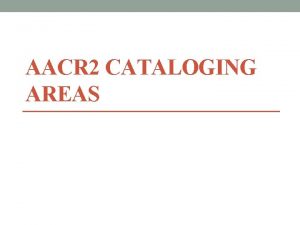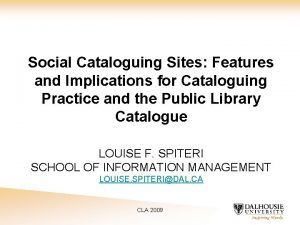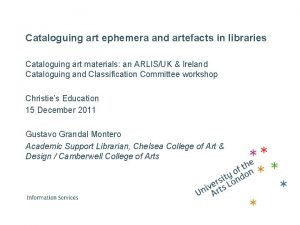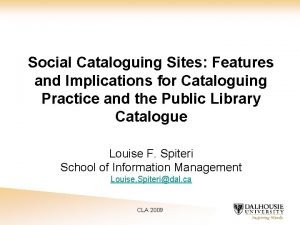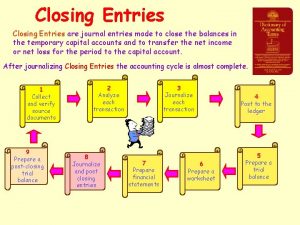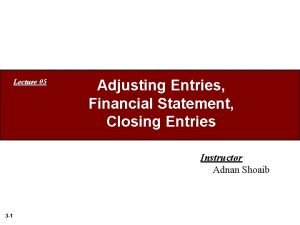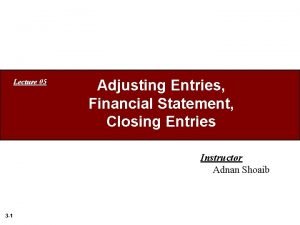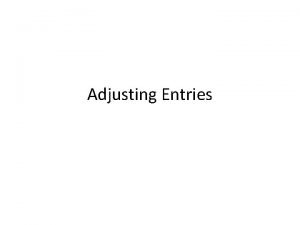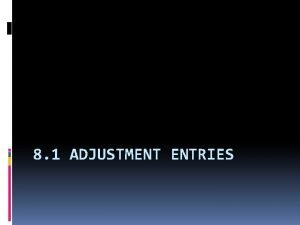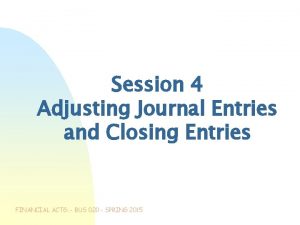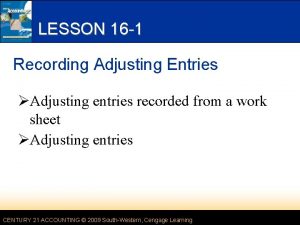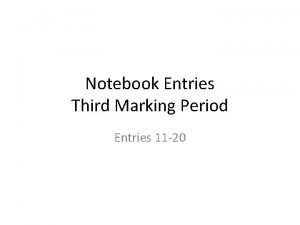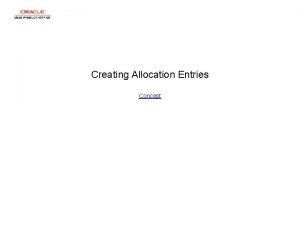TYPES OF ENTRIES Introduction AACR 2Anglo American Cataloguing





















- Slides: 21

TYPES OF ENTRIES

Introduction AACR 2(Anglo American Cataloguing Rules, Edition 2) is meant for a Dictionary catalogue. In a dictionary catalogue all the entries are arranged alphabetically. Entries, according to AACR 2, can be broadly categorized into three types as follows: 1. Main Entry 2. Added Entries 3. Reference Entries

Main Entry v Main entry is “ the complete catalogue record of an item, presented in the form by which the entity is to be uniformly identified and cited. v The main entry may include the tracing of all other heading under which the record is to represented in the catalogue”(AACR 2, p. 567)

Main Entry: E. g. C N 69 5427 Gaudefroy- Demombynes, Maurice Physics/Maurice Gaudefroy- Demombynes. 2 nd rev. ed, - Newyork: Eeinhold, 1969. x, 415 p. : illus. ; 18 cm. -(Scientific monograph series; no. 7) Bibliography: p. 390 -410 ISBN 0 -83893 -530 -0 1. Physics. I. Title. II Series

Added Entry v Added entry is the secondary record of the document other than the main entry. AACR 2 glossary defines it to be “ an entry, additional to main entry by which an item is represented in a catalogue”. v Many added entries are prepared for one document and these entries help easy identification and location of documents by the users. v For example, if the main entry is prepared under the name of an author, added entries may be prepared under the joint author, collaborate, title, series or under any other specification by which the document is reasonably sought the catalogue.

Reference Entry v According to AACR 2 Glossary, a reference entry is “ a direction from one heading to another”. Reference entries include ‘See’ and ‘See also’ entries etc. v Unit Card System simplifies the process of preparing added entries. In this system one main entry card with complete cataloguing information is prepared. v The same set of information is repeated exactly in all the added entries different headings which form the possible points of access to users.

Preparation of Entries An entry is a record of an item in a catalogue. Entries render the description of documents. Description id divided into the following areas always cited in the order shown below 1. Title and Statement of responsibility. 2. Edition 3. Material(or type of publication), specific details

cont 4. Publication, distribution etc. 5. Physical description 6. Series 7. Note(s) 8. Standard Number and terms of availability.

cont v Each area other than the first area is preceded by a full stop, space, dash, space (. -). Alternatively, an area can begin a new paragraph. v Elements within areas must also be divided by consistent punctuation. For example, statement of responsibility is always preceded by a diagonal slash. E. g. . Tomsawyer/ Mark Twain v The puncation, that separates place of publication from publisher and date within the publication etc. is Colon. E. g. Place: Publisher, Date London: Clive Bingley, 1987.

cont v Each mark of prescribed punctuation is preceded by a space and followed by a space, except for a comma, full stop and opening and closing paranthesis. v Rule 1. 0 D contains specification of different levels of descriptions. Three levels of details in the descriptions have been prescribed by the code. They are given under along with elements to be include under each.

Levels of Description Falls into three levels viz, 1. First level of description 2. Second level of description 3. Third level of description

First level description This includes the following elements given below. Title and statement of responsibility-Edition. Material (or type of publication). Specific details. Publication, Distribution, etc. - Physical description. - (series). - Note(s). -Standard Number.

Second level description This includes the following: Title proper( general material designation)= Parallel title : other title information / first statement of responsibility ; each subsequent statement of responsibility. – Edition statement / First statement of responsibility relating to the edition. – Material (or type of publication) specific details. – First place of publication etc. : First Publisher etc. , date of publication , etc. – Extent of item : other physical details ; dimensions. - (Titles proper of series/ Statement of responsibility relating to Series, ISSN of series; numbering within the series. Title of subseries, ISSN of subseries; numbering within subseries. - Note(s). - Standard Number.

Third level description A directive has been given under Rule 1. 0 D 3 to the effect that the third level of description will be in accordance with the rules that are applicable to the item being described.

Catalogue Card Details v. The standard size of Catalogue is 12. 5 x 7. 5 0. 01 mm. The card is divided into three indentions for the convenience of the cataloguers. v. We find the indentions printed vertically and parallel to the shorter edge (width) of the card. These are 1. First indention: First vertical line is drawn at the 8 th type space from the left edge of the cord.

cont 2. Second indention: It is the second vertical line and is drawn at the 12 th type space from the left edge. 3. Third indention: It is not printed on the card but is supposed to be drawn at the 14 th type space from the left edge. Headline: The headline is drawn at the 4 th type space from the top of the card. An illustration is given below.

cont B A C D O A-headline , B-first indention, C- Second indention, D- Third indention

Position for different elements in the entry The following rules for different positions for the different elements in the catalogue entry should be observed. 1. Class Number should be written on the 4 th line from the top of the card i. e. on the head line beginning from the second type space from the left edge of the card. 2. Book Number should be written on 5 th line from the top of the card i. e just below the class number. 3. The Head Line will be left blank a the stage of writing description

cont 4. The TITLE should start from the Second Indention on a line below the head line. 5. The TITLE and STATEMENT OF RESPONSIBILITY AREA, the edition area, the material ( or type of publication) specific details area, and the publication, distribution etc. area will form a single paragraph. 6. The PHYSICAL DESCRIPTION AREA will start from the second indention and will include SERIES AREA also. Both these elements will form a separate paragraph. 7. The NOTE AREA will start from the second indention. If there are more than one note, they may be given in a separate paragraph.

Punctuation v The punctuation marks play an important role and with this only we can identify the different elements in the catalogue. v The punctuation marks employed in the entries according to AACR 2 are ten as detailed below: v Square bracket [ ] Semicolon ; v Equal Sign = Plus v Colon : Paranthesis ( ) v Diagonal Slash / Hyphen - v Comma , Full stop . +

Conclusion Main entry and Added entries may be modified as per the local variation rules.
 Procainoterapia
Procainoterapia Canon of ascertainability
Canon of ascertainability What is descriptive cataloguing
What is descriptive cataloguing Cataloguing codes
Cataloguing codes Koha cataloguing module
Koha cataloguing module Types of entries in aacr2
Types of entries in aacr2 Adjusting process in accounting
Adjusting process in accounting What are the 3 types of catalogue?
What are the 3 types of catalogue? Dark romantic literature
Dark romantic literature Introduction to twi for american diasporas
Introduction to twi for american diasporas Journalizing adjusting entries
Journalizing adjusting entries To kill a mockingbird journal entries by chapter
To kill a mockingbird journal entries by chapter Great gatsby writing prompts
Great gatsby writing prompts Freedom writers diary entries
Freedom writers diary entries Journalize adjusting entries
Journalize adjusting entries Closing revenue accounts
Closing revenue accounts How does katniss plan to strike at the careers
How does katniss plan to strike at the careers Romeo and juliet journal entries
Romeo and juliet journal entries Post. ref. column in the general journal
Post. ref. column in the general journal For works cited entries how is an author’s name listed
For works cited entries how is an author’s name listed Logbook entry sample
Logbook entry sample Lewis and clark journal entries project
Lewis and clark journal entries project


